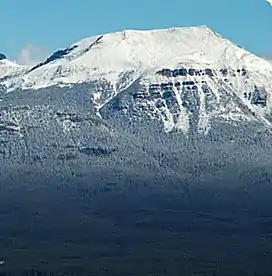| Lipalian Mountain | |
|---|---|
 | |
| Highest point | |
| Elevation | 2,682 m (8,799 ft)[1] |
| Prominence | 152 m (499 ft)[2] |
| Parent peak | Redoubt Mountain (2902 m)[2] |
| Listing | Mountains of Alberta |
| Coordinates | 51°25′37″N 116°05′50″W / 51.42694°N 116.09722°W[3] |
| Geography | |
 Lipalian Mountain Location of Lipalian Mountain in Alberta  Lipalian Mountain Lipalian Mountain (Canada) | |
| Location | Alberta, Canada |
| Parent range | Slate Range Canadian Rockies |
| Topo map | NTS 82N8 Lake Louise[3] |
Lipalian Mountain is a 2,682-metre (8,799-foot) mountain summit located in Banff National Park, in the Slate Range of the Canadian Rockies of Alberta, Canada. It was named by William C. Gussow in 1958.[1][2] Lipalian was a geological era proposed by American paleontologist Charles Walcott for a time where there is no record of fossils during a period of the Cambrian explosion. The theory was later refuted.
Geology
The mountains in Banff Park are composed of sedimentary rock laid down during the Precambrian to Jurassic periods.[4] Formed in shallow seas, this sedimentary rock was pushed east and over the top of younger rock during the Laramide orogeny.[5]
Climate
Based on the Köppen climate classification, the mountain experiences a subarctic climate with cold, snowy winters, and mild summers.[6] The Lake Louise Ski Resort is located to the immediate northwest of the peak. Temperatures can drop below -20 °C with wind chill factors below -30 °C in the winter.
See also

References
- 1 2 "Lipalian Mountain". cdnrockiesdatabases.ca. Retrieved 2019-09-07.
- 1 2 3 "Lipalian Mountain". Bivouac.com. Retrieved 2019-09-07.
- 1 2 "Lipalian Mountain". Geographical Names Data Base. Natural Resources Canada. Retrieved 2019-09-07.
- ↑ Belyea, Helen R. (1960). The Story of the Mountains in Banff National Park (PDF). parkscanadahistory.com (Report). Ottawa: Geological Survey of Canada. Archived (PDF) from the original on 2015-10-02. Retrieved 2019-09-13.
- ↑ Gadd, Ben (2008). "Geology of the Rocky Mountains and Columbias".
{{cite journal}}: Cite journal requires|journal=(help) - ↑ Peel, M. C.; Finlayson, B. L.; McMahon, T. A. (2007). "Updated world map of the Köppen−Geiger climate classification". Hydrol. Earth Syst. Sci. 11: 1633–1644. ISSN 1027-5606.
External links
- Parks Canada web site: Banff National Park